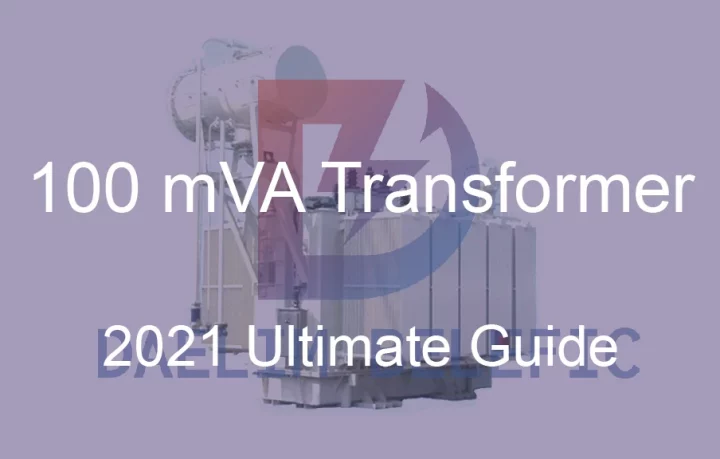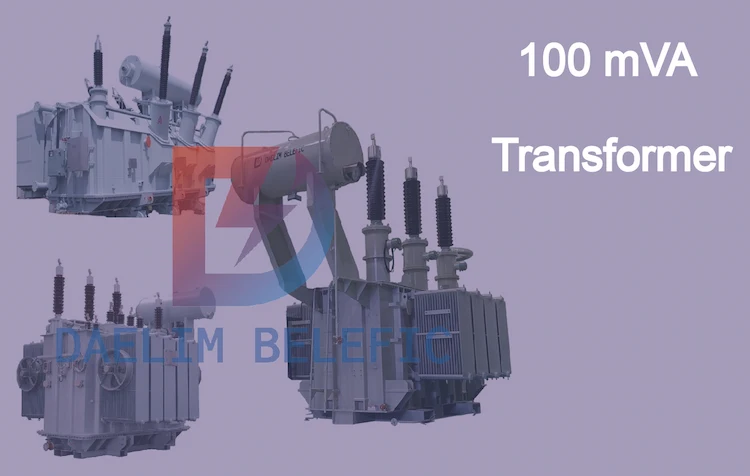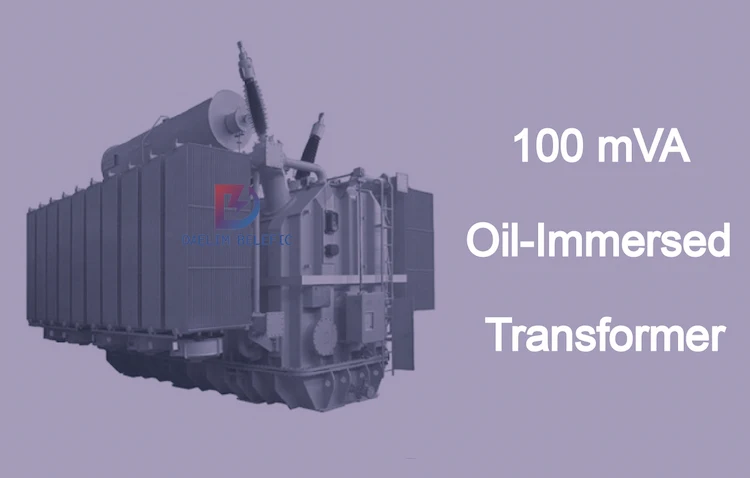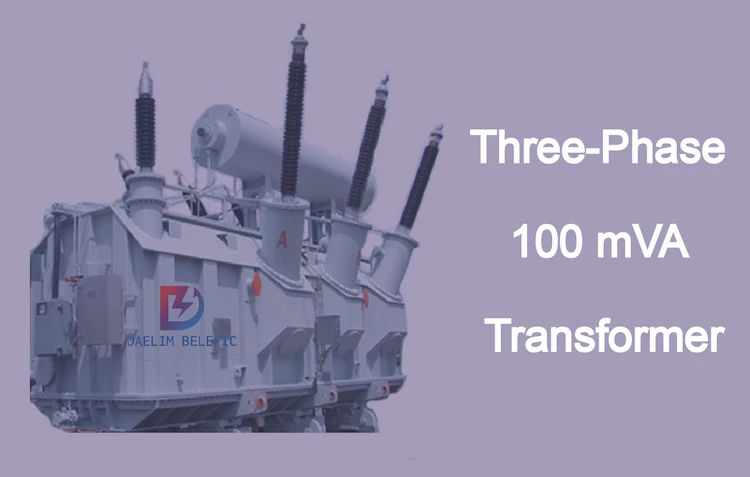ELECTRIC, WITH AN EDGE

In our modern age today, we find electronics everywhere. The 100 mVA Transformer, for example, transmits electrical energy to places where it’s needed.
The most common type of power transformer is the High voltage transformer.
This transformer is typically used in motor vehicles to power electric motors.
Moreover, these are also used in recreational boats or generators and large or high voltage commercial systems.
This article will discuss the 100 mVA Transformer, what it is, what it does, and what makes it unique from other kinds of transformers.
DAELIM offers the best quality transformers in the market.
For over 15 years, they have been manufacturing high-quality electric products and equipment to meet their customer’s needs.
Furthermore, DAELIM is committed to continuous improvement by quality guidelines and practices.
Ultimate 132kV Transformer Guide
-Our homes are powered by electricity. But have you wondered how electricity is transmitted? This article discusses the 132kv Transformer.
2022 Ultimate 11kV Transformer Guide
-This article will cover the important details of an 11Kv transformer. Help you better to know what is the 11kV transformer. Read on!
2021 Ultimate 400kV Transformer Guide
-Read here to know more details and be informed about the 400kV Transformer and how it can be beneficial in daily electrical transmission.
2021 Ultimate 33 kv Transformer Guide
-In this section, we want to briefly introduce how a 33 kv transformer works and what you can do with it. Read on!
100 mVA transformers are among the higher rating of transformers that usually fall into power or substation transformers.
It has a maximum rating of 130.50VA and is highly used for the generation and distribution of power.
It can be used for voltages ranging from 80 to 400volts.
This transformer is designed to withstand a high load current.
The ratings are expressed in VA, which represents the transfer of power.
Wiring for the transformer is universal double L-lead (not S-lead, S-lead is not good for transformer circuits due to its wear-time). L-lead is used for domestic, commercial, and industrial circuits.
A toroidal transformer is a kind of transformer that gets its name from its shape.
It has a core-like cylinder with a diameter of a few centimeters and an inner diameter of about a meter.
This transformer is made of twisted copper and has three or more cores, making it similar to a rope with small loops that are not parallel to each other.
Furthermore, it has two toroidal poles. When these poles align in a “convex” configuration, the magnetic energy in the two magnetic fields is forced to radiate away in the opposite direction.
This type of transformer tends to be used for large-scale applications due to its higher efficiency at high voltages and currents.
Every transformer has its magnetic field. The field, which is the strength and direction of the magnetic field, comes directly from the primary winding.
With a toroidal transformer, the magnetic fields generated from the two poles are in the opposite direction. As the currents in the transformer increase, the strength of the magnetic field also decreases.

The toroidal transformers have several advantages over conventional transformers.
Toroidal transformers are expensive; therefore, the final production cost can be quite high.
Although these transformers have no primary winding, they still have secondary windings within the transformer, spinning the primary winding.
Although toroidal transformers produce less stray magnetic energy, their magnetic fields are still subject to component drift.
So, it is not recommended to use toroidal transformers with high current ratings.
A two-winding transformer produces both AC and DC, which are required for different purposes.
The primary purpose of a double winding transformer is to increase the speed of the flow of current.
However, the secondary purpose of the double winding transformer is to help in voltage regulation.
This transformer is used in most electronic products.
The functions of the double winding transformer are voltage conversion and stabilization, impedance transformation, isolation, etc.
E-type and C-type shape cores are commonly used for two-winding transformers.
A two-winding coil transformer is most suitable for low voltage electronics like transformers, rectifiers, sensors, converters, circuit protection, etc.
E-type double winding transformers are widely used in AC generation applications.
The transformers with the wound core have more important features, such as large stability, high quality, resistance, higher efficiency, high reliability, environmental compatibility, etc.
Typically, large transformers like this go with Oil-cooling as it is more efficient. Nonetheless, few models exist in dry types but are very rare. Oil is not used as a coolant; rather, it cools the blades, windings, and core.
Oil is used to circulate the air to maintain a constant temperature in the core of the transformer. The Oil coolants contain additives for corrosion resistance and facilitate the convection process, and oil is also anodes.
Furthermore, oil-cooled transformers work well with small-scale transformers and can safely withstand the use of voltages higher than 200V, and can operate under 50°C to 75°C.

The primary disadvantage of the oil-cooled transformer is that the heat is transferred to the surrounding atmosphere, and the cooling is only applied to the core.
Moreover, oil is a good insulator, and as a result, the resulting transformer temperatures are high. Cooled Transformers are not modular and prone to leaks.
Another disadvantage of an oil-cooled transformer is the flow characteristics of the oil. Depending on the application, the oil has flow properties, either high, medium, or low.
If the transformer is filled with oil, the oil can be pressurized, which causes excessive thermal resistance in the air (the radiator for the oil).
A three-phase transformer is often used to convert the voltage of a three-phase electrical system from 120V to 220V. There are three phases in the transformer: positive, negative, and neutral.

Three-phase transformers provide long-lasting efficiency. In contrast to others, this type of transformer is designed to withstand high-power voltages.
Consequently, they are comparatively safe for electricity distribution and therefore preferred by the utility companies to use. These transformers are easy to repair and are also rather cheap.
A single three-phase transformer can be easily replaced with other spare transformers of the same type if the fault is discovered in its circuit.
The main disadvantage is that installing a three-phase transformer in a particular circuit takes more time and space.
Some other disadvantages of using a three-phase transformer are the high cost involved and difficulty of maintenance.
A 100 mVA transformer is a transformer that has a maximum rating of 130.50VA. It is highly used for the generation and distribution of power. The transformer can be used for voltages ranging from 80 to 400volts.
KVA is the output voltage rating of a transformer, VA is the output current rating. MVA is the ratio of input voltage to output current, or in other words, MVA is the ratio of the input voltage to the output voltage.
The input voltage for an operational transformer in an AC power system is defined as input voltage X current. VA and KVA are used for AC Power System, MVA is used for DC Power System.
Electricity ratings range from 300kW to 3,500kW, ideal for an alternating current motor or generator based on the kW head (unit of power).
MVA and MW are metering standards and measure the average power output. MVA denotes the average power output when it is completely loaded onboard and does not require additional power from the generator.
In contrast, MW denotes the average power output when loaded with power as described in the previous paragraph. So, 3,500kW (or 300kW) motor capacity is equivalent to 3,500MVA, which are of the same metering standard, and therefore MVA and MW are equivalent.
If your transformer blew up, you are possibly wondering what could have been the cause.
A transformer being overloaded tends to overheat and eventually overheat a combination of positive and negative terminals.
These terminals are connected by insulated conductors that conduct electricity.
The more power they receive, the more electricity they can carry. Overloading the transmission lines can cause the conductors to become extremely hot.
Lightning can also be a possible cause of a transformer explosion.
The higher the voltages that the transmission lines are carrying, the more power they can carry.
When lightning strikes a transformer, the power may be transferred to the conductors at incredibly high voltages.
A blown transformer is a situation where the transformer’s parts malfunction.
It occurs when there is an energy spike, followed by a massive spike in the grid.
Ordinarily, the transformer usually runs at a rate of 20 cycles per second (i.e., 20 milliamps per second).
A power surge will cause the parts to be energized and compressed, creating an incredibly loud sound heard as a loud explosion.
Transformers provide efficient protection to all the essential equipment used in electrical power generation and distribution.
They have a strong electrical wire and, as such, have good capabilities in handling large currents.
Get in touch with DAELIM today for high-quality electric products. We are a reliable company whose mission is always to exceed our customers’ expectations through high-quality services.
If you find that the existing distribution transformer types or power cannot meet your requirements. You can choose to tell Daelim. Daelim has a team that has always had a wealth of design transformers, and can give you a specific design plan in the shortest time.
Daelim’s distribution transformers comply with IEEE, ANSI, CSA, IEC certification, and are used in North America (such as Canada, the United States, Mexico), South America (such as Ecuador, Chile), Europe (such as Spain, Lithuania) and some Asian countries. Daelim even has a professional installation team that can provide you with installation services.
ELECTRIC, WITH AN ENGE-- DAELIM BELEFIC